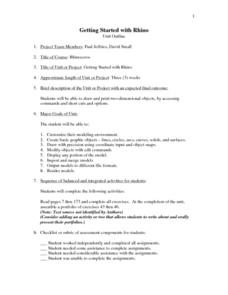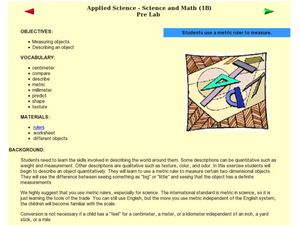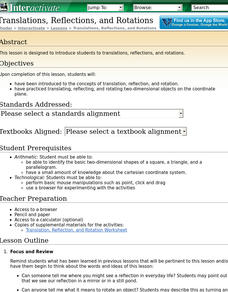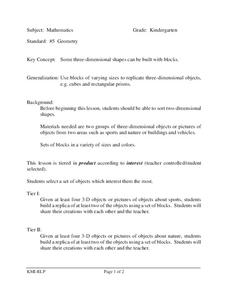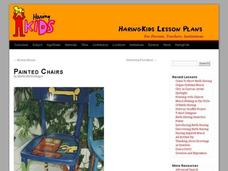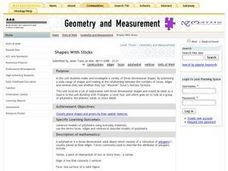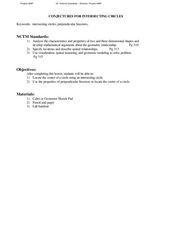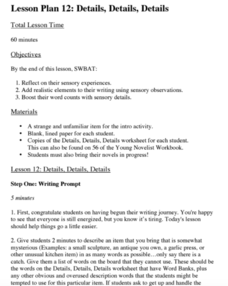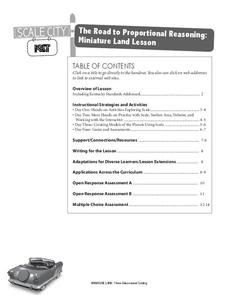Curated OER
Exploring the Properties of Rectangular Prisms.
Learners define properties of rectangular prisms. In this geometry lesson, students identify the relationship between two and three dimensional objects. They use Cabri technology to graph their figures.
Curated OER
Boxing On
Students participate in five center activities in which they construct three dimensional objects using cubic centimeter manipulatives such as sugar cubes and toothpaste boxes. They determine the volume of the objects. They build a model...
Curated OER
Getting Started With Rhino
Students draw and print two-dimensional objects, by accessing commands and short cuts and options. They customize their modeling environment, create basic graphic objects - lines, circles, arcs, curves, solids, and surfaces, and draw...
Curated OER
Using a Metric Ruler
Students explore measuring with metric rulers. In this math instructional activity, students measure two-dimensional objects using metric units.
Curated OER
Compass Designs
Young scholars investigate the properties of two and three dimensional objects. In this geometry instructional activity, students differentiate polygons based on similarity and congruence. They make observation and interpret the data.
Curated OER
Translations, Reflections, and Rotations
Tenth graders have been introduced to the concepts of translation, reflection, and rotation, and have practiced translating, reflecting, and rotating two-dimensional objects on the coordinate plane.
Curated OER
3-D Figures Part 2
Students work with three dimensional objects. In this geometry lesson, students examine models of spheres, cones, cubes, prisms, and pyramids, and identify them by their edges, vertices, and faces.
Curated OER
What do two-dimensional tessellations look like? Where in art can they be found?
Young scholars explore the world of art and culture, including the works of M.C. Escher. They identify and create original tessellations. Students use a wealth of interactive multimedia applications. They explore the artistic...
Curated OER
Geometry
Students build replicas about nature and sports. In this geometry lesson plan, students build 3D replicas of nature and sports objects in teams.
Curated OER
Painted Chairs
Students evaluate visual arts by creating furniture designs. For this three dimensional art lesson, students utilize the web to examine different artist renderings of furniture, sculpture and architecture. Students utilize paint to...
Curated OER
A Sphere and Its Net
Students identify and sketch the nets for sphere. In this geometry instructional activity, students differentiate between two and three dimensional shapes. They find the surface area of each sphere.
Curated OER
Squares to Compare
Students investigate how to draw and classify two and three dimensional figures (squares, triangles, rectangles.)
Curated OER
Make a Box
Young scholars use specific dimensions to create a box. In this geometry lesson plan, students analyze the different properties of two and three dimensional shapes. They make conjectures and use it to solve problems.
Curated OER
Shapes with Sticks
Third graders investigate three dimensional shapes. They examine a variety of shapes and the relationship between the number of faces, edges, and vertices. Students determine Euler's formula and they create a variety of three dimensional...
Curated OER
The Louis Vuitton Project, using 3rd degree equations
Students model three-dimensional objects using cubes. In this geometry activity, students calculate the volume and derived the amount mathematically. They use different objects to create two and three-dimensional objects.
Curated OER
Seeing through Touch
Students explore solid objects using touch. In this art lesson, students are blindfolded and given a 3 dimensional object to explore with their hands. After the object is removed, students draw what they think the object looked like....
Curated OER
Swirling, Twirling, Glistening Jewels... Glass Art In Words
Students examine the art form of the glass sculpture. After viewing a three dimensional object, they write creatively describing the object through the use of metaphors. They use peer editing to check for grammatical and spelling errors.
Curated OER
Artifacts: Bringing the Past Back to Life -- the Mexican Case
Young scholars examine and discuss the meanings of the various symbols in Tenochtitlan. In groups, they complete a part of the model of the city and discuss the importance of finding artifacts. Individually, they choose an a...
Curated OER
Conjectures of Intersecting Circles
Young scholars make conjectures of intersecting circles. In this geometry lesson, students observe circles and their position in space. They investigate and observe two and three dimensional objects.
Curated OER
Platonic Solids
Students identify different types of polygons. In this geometry lesson, students differentiate between convex and regular shapes. they identify the names of two and three-dimensional objects.
Utah Education Network (UEN)
Insides and Outsides
Give small groups handfuls of unit cubes and then dare them to build as many rectangular prisms as possible using only 12 cubes. This engaging activity serves as an introduction to the volume of solid figures. In addition to volume,...
Curated OER
Details, Details, Details
Writing can become one-dimensional if authors don't involve all their senses. First, scholars observe a strange object which, ideally, they can touch and even smell. Without using certain words (you can create a list or have the class...
Technical Sketching
Introduction — Surfaces and Edges
How different can 3-D and 2-D really be? An engineering resource provides an explanation about the importance of two-dimensional technical drawings. Several samples show how to create multi-view drawings from pictorials and...
Kentucky Educational Television
The Road to Proportional Reasoning
Just how big would it really be? Young mathematicians determine if different toys are proportional and if their scale is accurate. They solve problems relating scale along with volume and surface area using manipulatives. The...
Other popular searches
- 3 Dimensional Objects
- Three Dimensional Objects
- Three Dimensional Objects
- Two Dimensional Objects
- 3 Dimensional Objects
- Making 3 Dimensional Objects


